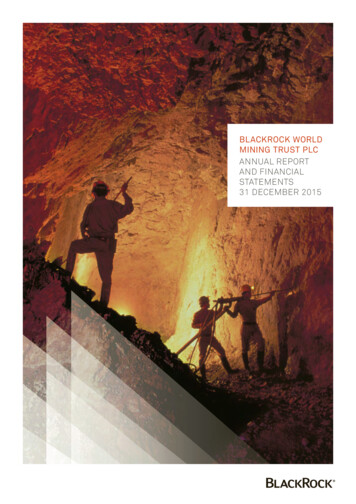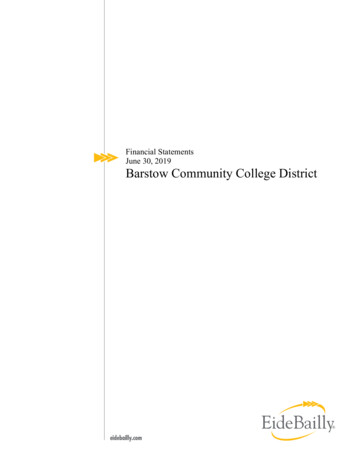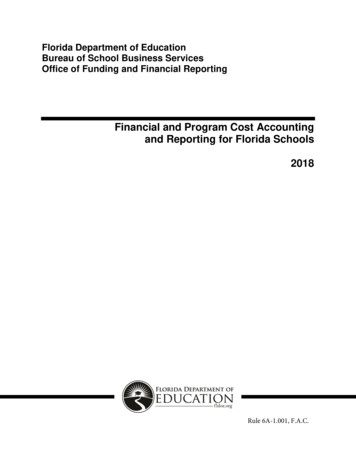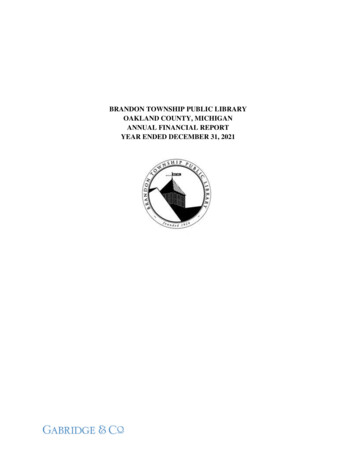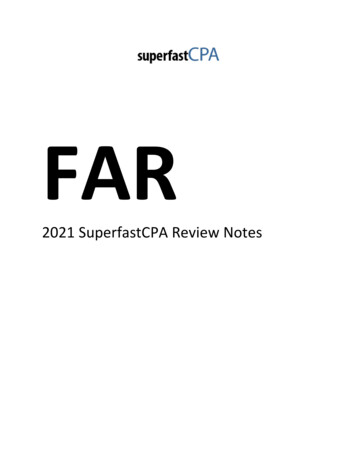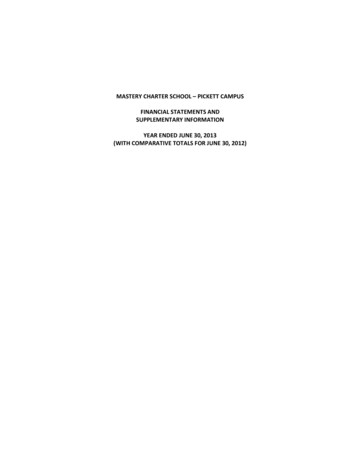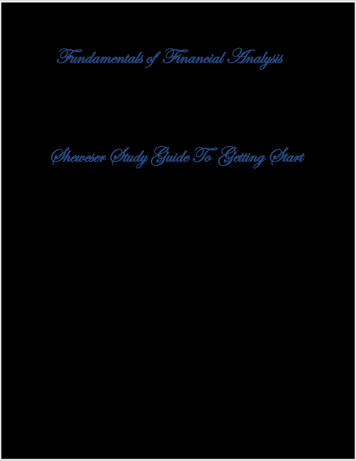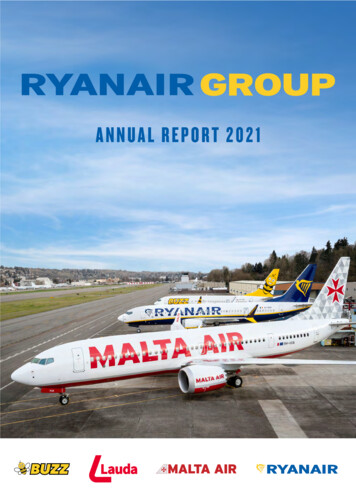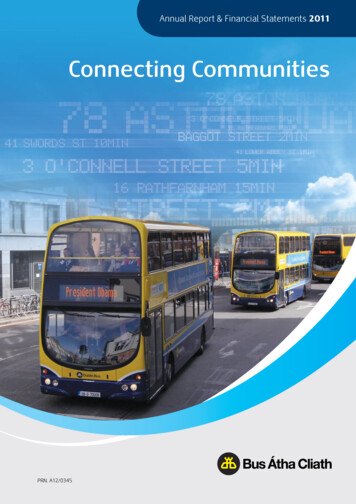
Transcription
Annual Report & Financial Statements 2011Connecting CommunitiesPRN. A12/0345
Annual Report & Financial Statements 2011In 2011 Bus Átha Cliath staged 19 publicconsultation sessions and implementedNetwork Direct proposals in 22 areasthroughout the network.
ContentsOperations Review. 2Directors and Other Information.10Report of the Directors. 12Board of Directors.16Statement of Directors’ Responsibilities.18Report of the Auditors.19Principal Accounting Policies.22Profit and Loss Account.23Balance Sheet.24Cash Flow Statement.25Notes to the Financial Statements.26Bus Átha Cliath would like to acknowledge funding on majorprojects by the Irish Government under the National DevelopmentPlan 2007-2013 as well as co-funding by the European Union.
Annual Report & Financial Statements 2011Operations ReviewOverviewThe economic environment continued to be a majorinfluence on demand for services during the year but byyear end the rate of decline compared to previous yearshad slowed appreciably. The process of bringing costsin line with lower revenue continued and by end 2011recurring annual cost savings of 60 million and once-offcost reductions of 13 million had been generated. Someprogress in returning to profitability was achieved in 2011and this is expected to continue into 2012. It is reasonableto expect that this objective can be achieved within thenext few years, with the support of stakeholders.2011 was a year of many developments for BusÁtha Cliath. The Network Direct Project continued tosuccessfully redesign services to match customerdemand and to adjust service timetables in line withrunning time improvements and bus priority measures.The project, which commenced in 2010 following astrategic review of the operations of the company,involves a complex matrix of; timetable changes, staffreductions, bus fleet reduction, new termini, new routes,cancelled routes and staff working arrangements. Itrequired extensive consultations with many stakeholdersand a lengthy and detailed communications programme.In 2011 Bus Átha Cliath staged 19 public consultationsessions and implemented Network Direct proposalsin 22 areas throughout the network. Network Directrevisions introduced in 2010 have all recorded increasesin passenger numbers and it is anticipated that 2011revisions will yield the same results. Marketing campaignshave been devised to promote the benefits of the 2011revised services. The project is scheduled for completionin early 2012.social media to instantly disseminate information isparticularly valuable during instances where services arenegatively impacted by factors beyond its control suchas the adverse weather conditions of October or therolling traffic diversions, which were enforced during thestate visits of U.S. President Barack Obama and QueenElizabeth II of Great Britain in May.Other achievements for Bus Átha Cliath in 2011 includedthe increase in low floor accessible routes (movingthe company further to a fully accessible fleet by theclose of 2012), the on-going success of the Certificateof Professional Competence, improvements to Bus ÁthaCliath’s commercial Airlink services and the internationalrecognition awarded to its commercial tour services. Aseries of service upgrades to Bus Átha Cliath’s fleet andthe implementation of energy efficiency measures havealso been key elements of the developments undertakenthis year. Bus Átha Cliath aims to build on the progressmade in 2011 throughout the course of 2012.2011 Operating ResultBus Átha Cliath incurred a deficit of 18.2 million in 2011,compared to a deficit of 22.1 million in 2010.Along with implementing Network Direct revisions, 2011has also seen long term technological projects cometo fruition. 2011 saw the completion of the AutomaticVehicle Location and Control system (AVLC) facilitating theintroduction of Real Time Passenger Information (RTPI)as a benefit available to all Bus Átha Cliath customers viawebsite, iPhone and Android app and on-street RTPI units.The majority of commuters seeking RTPI informationnow have virtually instant access to it. The Leap Cardwas launched in late 2011 and further phases of productdevelopments will take place during 2012.The economic environment was again very difficult butcustomer demand held up well and finished the year1.7% down on the previous year. Total passenger journeysamounted to 117 million in 2011 compared to 119 millionin 2010. Passenger revenue stabilised at 170.0 millioncompared to 170.3 million in 2010 but the advertisingmarket suffered from lower volumes and reduced ratesresulting in a 2.8 million (26%) reduction in revenueearned from on-bus and bus shelter advertising. Inthe prevailing market conditions it was very difficultto recover a further cut of 2.7 million (3.6%) in PublicService Contract (PSC) payments through revenuegrowth. Revenue from other activities was 0.6 millionlower. The National Transport Authority (NTA) approved anaverage fares increase of 3% which also helped to defrayincreased fuel and new Integrated Ticketing System (ITS)operating costs. The fares increase was implemented forcash fares on 7th February and for prepaid fares on 1stMay. Total revenue, including PSC payments, reduced by 6.5 million.In 2011 Bus Átha Cliath entered the world of social mediawith official Facebook and Twitter accounts provingto be invaluable tools in informing our customers ofBus Átha Cliath services and promotions. The ability ofBus Átha Cliath has worked very hard to implementmeasures to deal with the effects of the recession.Through the progress achieved in implementingNetwork Direct in 2011, the pace of cost reductions has2
Operations Review (continued)2011 was year of many developmentsfor Bus Átha Cliath. An Automatic VehicleLocation and Control (AVLC) system becamefully operational in all Bus Átha Cliath’sdepots in 2011.3
Annual Report & Financial Statements 2011Operations Review (continued)accelerated. Operating costs were reduced by 13.7million but increased fuel and ITS costs resulted in a netyear-on-year reduction of 10.7 million. Since 2008, grosscost savings of 60 million have been generated acrossall areas of expenditure in the company. Unfortunately,cost increases, primarily in fuel taxes, have eroded thesavings to a net betterment of 40 million.Total payroll savings of 6.6m were achieved during theyear and these will amount to approximately 12 millionin a full year. These savings were generated mainlythrough headcount reduction as a result of the revisednetwork of services, faster journey times and efficiencygains. Average staff numbers employed declined by 217(6%) and the full year effect will bring the reduction to9% in 2012. Since 2008, the average number of staffemployed has reduced by 480 and this will exceed 600(16%) in 2012. Over the same period, 24 million has beensaved in payroll costs.Apart from savings in payroll costs, significant reductionswere also achieved in depreciation charges and in thecost of administration and support services. Over 200buses have been taken out of the fleet and not replaced inrecent years. In addition the average life of buses has beenextended from 10 years to 12 years resulting in a reduceddepreciation charge but this is mitigated to some extentby increased maintenance and refurbishment costs.The intensive efforts at reducing costs have been largelysuccessful in offsetting the decrease in customerrevenues over recent years and the Department ofTransport, Tourism & Sport and the NTA have receivedindependent confirmation that Bus Átha Cliath is anefficient transport operator. However recent annualreductions in subvention and increases in fuel taxes havecontributed to a significant underpayment for servicesprovided under the Public Services Contract with ashortfall of 19 million being recorded in 2011 comparedto a shortfall of 22.7 million in 2010.Successive deficits have eroded the capital base of thecompany and net assets at end 2010 amounted to only 1.6 million. Based on the deficit for 2011 the net assetswould have been negative 16.5 million at end 2011. Inorder to be in a position to comply with the EuropeanCommunities (Road Passenger Transport) Regulations,1991 to 1999 when the company applies for renewalof its Road Passenger Transport Operator’s Licence, BusÁtha Cliath issued 30 million ordinary shares to CIÉ inDecember 2011. As a result net assets at 31st December2011 amounted to 21.5 million.4While the share issue strengthens the Bus Átha Cliathbalance sheet it does not help reduce the drain on theCIÉ Group cash resources caused by the annual operatingdeficits. A five year financial plan has been developedand presented to the Department of Transport, Tourism& Sport. It is envisaged that the company will return toprofitable trading in 2014. Successful implementation ofthe plan requires an agreed multi-annual approach to;continuing cost reductions, fares and subvention, andsome modest growth in the economy in 2014 and 2015.Bus Átha Cliath NetworkDirectThroughout 2011 Bus Átha Cliath continued to progressthe Route Network Review under the banner of NetworkDirect. Although the implementation of the projectcommenced in 2010, 2011 was the year in which the vastmajority of revisions were introduced. The Network Directproject is the outcome of the widest ranging review ofthe Bus Átha Cliath network in the history of the companyand is bringing significant benefits to customers. As partof Network Direct, Bus Átha Cliath carried out in-depthresearch and analysis into the current travel patterns ofcustomers, customer experiences and expectations oftheir bus service. Up to one million journeys to work,across all transport modes, were analysed in detail toestablish the current travel demands and patterns. BusÁtha Cliath also analysed its own data and assessedalmost half a million customer movements each dayalong with journey times across the entire city. All serviceproposals and revisions were based on this extensiveresearch and comply with the 2009 Cost and EfficiencyReview of Bus Átha Cliath undertaken by Deloitte.The aim of the Network Direct project is todeliver:l An increase in the number of high frequencyroutes (10 minute headway or better in peaktimes);l More direct alignments to/from key areas ofwork/leisure;l Greater use of Quality Bus Corridors (QBC);l Even headways from departure points on acorridor basis;
Operations Review (continued)l Less route variations making the network easierto understand;Northern Orbital Routes – Passenger numbers increasedby 15%l A new network of more direct orbital services;The major elements of Network Direct were substantiallyimplemented by June 2012.l An increase in cross city routes to minimisecustomer interchange; andl Improved connections with Rail and Luastransport modes.Prior to the implementation of Network Direct in eacharea, Bus Átha Cliath undertook an in-depth publicconsultation process, where customers were able toprovide feedback on the service proposals via e-mail,telephone and letter. This process was supported by aseries of local public consultation events where membersof the public could meet with senior Bus Átha Cliathrepresentatives who could address queries regardingdevelopments to local bus services. Where possible,Bus Átha Cliath incorporated the feedback into revisedservice proposals. Through a combination of the aboveelements, Bus Átha Cliath has designed a bus service thatmeets the changing needs of its customers and therebyencourages loyalty from existing customers and attractsnew users to our service.In 2011 Network Direct revisions were introduced in thefollowing areas:Areas revised under Network DirectBallinteerCrumlinMerrion TerenureMalahide RoadBus Átha Cliath has devised a service that meets thechanging needs of its customers and the results areevident in the following examples of increases inpassenger numbers by the end of 2011 along QBCs andrevised routes:Blanchardstown QBC – Passenger numbers increasedby 4%Stillorgan QBC – Passenger numbers increased by 2%Lucan QBC – Passenger numbers increased by 4%Advances in Real TimePassenger Information(RTPI)An Automatic Vehicle Location and Control (AVLC)system became fully operational in all Bus ÁthaCliath’s depots in 2011. The programme, funded by theDepartment of Transport, Tourism and Sport, ensuresgreater predictability and control of services and isthe infrastructure upon which Real Time PassengerInformation (RTPI) operates. The AVLC technology, fittedonto Bus Átha Cliath vehicles, feeds location data backto the Bus Átha Cliath Centralised Control Centre whereservices are monitored and regulated.Due to the progress of Bus Átha Cliath’s AVLC programme,in February 2011, Dublin City Council, on behalf of theNTA was able to launch the first 10 on-street RTPI displayscreens, which receive AVLC data and use it to provideRTPI. These 10 units were the first of a total of 272information screens now located throughout the BusÁtha Cliath network allowing customers to determinethe arrival time of their bus. Further display units arebeing deployed during 2012 and it is planned that a totalof 500 RTPI units will be located throughout the Bus ÁthaCliath network.In July Bus Átha Cliath launched an RTPI facility on itswebsite www.dublinbus.ie, ensuring greater ease ofaccess to RTPI for all customers. In conjunction withthis, Bus Átha Cliath launched an iPhone app. The appinitially contained a route planner, route timetablesand news items, but was upgraded and now providescustomers with an RTPI facility. iPhone users can checkthe actual arrival time of their bus at all 5,000 bus stopsand shelters on the Bus Átha Cliath network. The appwon Best Travel and Tourism App at the second annualAppy awards, which recognise and honour the best inapplication development for smart-phones, tablets andsocial media platforms. In December 2011 an Androidversion of this app was launched. Customer response toRTPI has been extremely positive with weekly requestsfor RTPI averaging at just over 700,000. In 2011 the BusÁtha Cliath website (www.dublinbus.ie) received Best IT5
Annual Report & Financial Statements 2011Operations Review (continued)Project of the Year (Public Sector) at the ICT ExcellenceAwards. The awards recognise the best in the Informationand Communications Technology Industry in Ireland.Launch of Leap CardIn December 2011 the Minister of State with responsibilityfor Public and Commuter Transport, along with theNTA, officially launched Leap Card, the new integratedtransport ticketing system for the Greater Dublin Area.The first phase of the project is the introduction of theLeap card which carries a reloadable stored value purse(or travel credit). It was launched simultaneously on BusÁtha Cliath, Iarnród Éireann and Luas services. The Leapcard offers customers discounts relative to the normalcash fares. During the next phase of development, thesystem will be enhanced with the introduction of dailyand weekly fares capping, transfer rebates (discounts fortransfer between services), automated top-up facilitiesand the implementation of all prepaid commuter ticketson the Leap card. Bus Átha Cliath, in conjunction withits ticket system supplier, and other transport operatorswill progressively deploy upgrades to their respectiveticketing systems to support the increased range offunctionality throughout 2012.Retaining and Attractingnew customersThe primary activity in retaining and attracting customersis the Network Direct project which is transformingthe network and will be complemented in 2012 bydevelopments in RTPI, Network Direct consultationand implementation and promotion of ‘Super Routes’.A mix of local and national press, area door-drops,on-bus leaflet distribution and information on the BusÁtha Cliath website were used to support Network DirectInformation and Promotion Campaign. RTPI launched inSeptember 2011 online, by SMS and via free iPhone andAndroid apps. A fully integrated marketing campaign ranin conjunction with the launch of RTPI including press,on-bus and online activity.A mix of advertising campaigns ran throughout 2011including:l Value-campaigns undertaken to promote the benefitsof taxsaver.ie and prepaid tickets;6l Added value and joint promotion – Bus Átha Cliath’s‘Ticket Thursdays’ campaign, which gives discountsto prepaid holders in participating city centre outletsand venues was run again in 2011; andl Route Specific promotions – Significant serviceimprovements have been made to key routes acrossthe city as part of Network Direct. A critical part ofthe recruitment strategy for the first half of 2011was to ‘sell’ these routes to non users, pushing theimproved connection and frequency features of theseroutes. Bus Átha Cliath implemented route specificcampaigns involving revised routes including: 9, 14,39a, 46a and 145.Launch and Importanceof Bus Átha Cliath SocialMediaIn March and April 2011 Bus Átha Cliath launched its officialFacebook and Twitter accounts (DublinBusNews) for thepurpose of providing service information, informationon Network Direct, and publicising the latest Bus ÁthaCliath promotions and launches. Social Media has provedto be a key tool in engaging with customers and, due tothe growing prevalence of smart phones, an effectiveway to instantly disseminate information. These toolsplayed a critically important role during the May 2011visits of Queen Elizabeth II of Great Britain and of U.S.President, Barrack Obama where Dublin City experiencedrolling traffic diversions throughout the course of thevisits. A significant number of Bus Átha Cliath serviceswere diverted but, through a thorough utilisation of itssocial media accounts, the company was able to keepits customers updated with all service developments.The importance of social media was also highlightedduring the flooding that Dublin experienced in Octoberwhere widespread flooding led to a significant numberof service diversions.Severe Weather 2011In October Dublin experienced a month’s fall of rain inthe space of one night and was subjected to wide scaleflooding causing significant traffic disruptions. Bus ÁthaCliath continued to provide a service for its customers.Both Luas and DART services experienced servicestoppages so, in many areas across Dublin, Bus ÁthaCliath was the sole public transport provider operating.Bus Átha Cliath’s experience of operating during the cold
Operations Review (continued)snap of late 2010 ensured that a contingency action planwas already in place to deal with the possibility of a reoccurrence of adverse weather conditions.Bus Átha Cliath’s centralised operations control inBroadstone acted as a base control throughout theduration of the bad weather. The presence of TrafficManagement CCTV screens in Operations Control and thedeployment of Chief Inspectors throughout the networkallowed Bus Átha Cliath to ascertain the standard ofthe roads. Based on this, Bus Átha Cliath introduced aseries of route curtailments and diversions that ensured,in the vast majority of cases, customers were able toget to their point of destination. All DART, suburban railand Luas tickets were honoured on Bus Átha Cliathservices ensuring that all commuters were able to getto and from work. Customers were updated on servicedevelopments via the website, social media pages andinformation phone lines, which operated extended hoursduring the duration of the bad weather. All media outletswere regularly briefed on service developments. Througha combination of the above practices, customers werekept up to date with all service developments.From October 27th to November 8th DART services weresuspended between Grand Canal Dock and Sydney Paradeto facilitate repairs to damages caused by flooding. BusÁtha Cliath honoured rail tickets for customers travellingsouth of Grand Canal Dock station and from November3rd Bus Átha Cliath operated a shuttle service betweenBooterstown and Pearse rail stations. Full rail serviceswere restored on November 8th.Public Service Contract- BusÁtha Cliath Continues toMeet its GoalsThe Public Service Contract has been in existencebetween the NTA and Bus Átha Cliath since December2009 and it sets out the network and range of servicesto be provided by Bus Átha Cliath, the performance levelsto be achieved under the public service obligation andthe compensation to be paid by the NTA for the provisionof these services. Bus Átha Cliath report quarterly to theNTA on the performance measurements and Bus ÁthaCliath has generally performed well. The NTA requirespayments it makes under the Public Service Contract tobe independently audited to verify that the contactedrequirements have been met by Bus Átha Cliath. Thesepayments amounted to 73.0 million in 2011 comparedto 75 .7 million in 2010. The Public Service Contract for2010 was independently audited on behalf of the NTAduring 2011 and the auditors concluded that Bus ÁthaCliath had met or exceeded the standard of performancespecified in the contract for PSO services. The auditorsstated that Bus Átha Cliath’s costs are consistent withthose of a ‘well-run’ public transport operator and notedthat there was a shortfall of 22.7 million in paymentsby the NTA to Bus Átha Cliath for the cost of deliveringPSO services in 2010.The Importance of a SafeWorkplaceThe board of Bus Átha Cliath and the ExecutiveManagement Team are committed to protecting thesafety, health and welfare of employees, customers andthose affected by our activities, such as other road users,visitors to our premises or contractors employed by thecompany.The company’s safety management system provides adetailed framework for the management of health andsafety risks associated with the company’s operations.Safety forms an integral part of the responsibilities ofsenior managers, middle managers and supervisorswho, in turn, must ensure that their employees fullyunderstand and comply with the requirements containedtherein.Whilst the requirement to provide adequate training andinstruction is enshrined in the requirements of the Safety,Health and Welfare at Work Act, 2005, Bus Átha Cliathcontinues to recognise the importance of exceedingthe minimum requirements by continually assessingthe competency requirements of its employees. Thisis reflected in its planned training programme whichincludes specific non-statutory training and regularin-house communication briefings relating to safetycritical information. The ongoing delivery of Certificate ofProfessional Competency (CPC) training continues to be aneffective means by which other safety-related informationcan be delivered. The company has also recently investedin a new driver training and evaluation system whichprovides for training by means of video assessment withsubsequent one to one feedback sessions.In relation to accidents, 2011 saw a significant reductionin the rate of collision accidents and customer accidentswith reductions of 13.5% and 6% respectively whencompared with 2010 figures. It is hoped that the rollout ofnew driver training to all drivers in early 2012 will help to7
Annual Report & Financial Statements 2011Operations Review (continued)provide for further reductions in these areas. In addition tothis new training initiative, the company also completeda revision of its ‘Dublin Bus Driver Safety Handbook’ inlate 2011. A copy of this booklet will be issued to eachdriver as part of scheduled training in early 2012.Fleet Accessibility – A busservice for everyoneIn 2011, Bus Átha Cliath continued to focus on enhancing theaccessibility of services for customers. An additional fourroutes were designated low floor wheelchair accessible in2011 and the Bus Átha Cliath fleet is now at 92% meaningthat that it is well on target to having a fully accessiblefleet by the end of 2012. The company’s Travel AssistanceScheme, which was introduced in 2007, continues toenjoy an increase in subscriptions with user figures in2011 over four times the user figures in 2007. The initiativewas designed to provide advice on using public transportservices to customers with reduced mobility, sensoryimpairments and learning disabilities. With the help of afull-time Bus Átha Cliath travel assistant, customers designa tailor-made travel plan, to suit his or her needs, ultimatelyleading to independent travel. Customers can accessmore information on Travel Assistance by contacting BusÁtha Cliath’s Accessibility Officer on (01) 7033204 or bye-mailing travelassist@dublinbus.ie.Corporate SocialResponsibility (CSR) – Ourwork in the CommunityBus Átha Cliath undertakes a series of Corporate SocialResponsibility (CSR) initiatives as a way of furthercommitting itself to the communities that it serveswithin the Greater Dublin Area (GDA). The 2011 BusÁtha Cliath Community Support Programme (CSP) wasthe biggest and most successful event in the history ofthe programme. The CSP, which celebrated its eighthyear in 2011, was established to help groups andorganisations in the Greater Dublin Area whose work,for the most part, goes unrecognised outside the circleof people they help. To date over 1,300 local charitiesand voluntary organisations from communities acrossthe GDA have benefited from the funding received fromthis programme. The cost of the programme is fundedthrough long term unclaimed passenger change.8Another CSR activity is the Children’s Art Competition,which utilises an annual art and poetry competition toinstil a respect for public transport amongst our youngercustomers. Some of the winning entries are incorporatedinto a Bus Átha Cliath calendar, which has proved to bepopular amongst older and younger customers alike. Theprogramme was launched in 2001 and has proved to beextremely effective in tackling anti-social behaviour onbuses and promoting a respect for public transport.An offshoot development from the Children’s ArtCompetition is the annual Niall Quinn Penalty Shootout,which was launched in 2003, where children receivecoaching from the former International Republic ofIreland football player. This year’s event took place inJune at the East Wall Community Centre.Shuttle Service forFestival EventsTwo high profile music events, Slane and Oxegen, tookplace during the summer of 2011. In both instances,Bus Átha Cliath provided a designated shuttle serviceto transport music fans to and from the events. For theSlane concert, Bus Átha Cliath provided 200 double deckbuses and in conjunction with the Gardaí, Meath CountyCouncil and the organisers put in place improved parkingand unloading procedures, which proved to be extremelysuccessful. For the Oxegen music festival which ran fromJuly 8th until July 10th, Bus Átha Cliath ran a shuttle serviceto the event in Punchestown. From June 30th to July 3rdthe Tall Ships Festival took place in Waterford and BusÁtha Cliath provided a Park and Ride shuttle service at theevent. In total 40 buses were deployed to Waterford forthe duration of the festival.Developments inCommercial ServicesIn June 2011, Bus Átha Cliath launched an improved Airlinkservice, which uses the Port Tunnel in both directions ofits route ensuring quicker journey times for customerstravelling to Dublin Airport. The new Airlink route alsoincorporates an increased number of hotels, guesthouses,tourist and business districts along its revised route. Theon-street information for Airlink was also redesignedto give it a more distinctive feel and make it easier torecognise. In February 2011, Bus Átha Cliath Hop-On HopOff Tour was voted top tour on hostelworld.com, based
Operations Review (continued)on the website’s customer reviews in 2010. Hostelworld.com is the world’s leading hostel booking website. In May2011 The Ghostbus Tour was awarded a 2011 Certificateof Excellence from the world’s top travel website, TripAdvisor, for consistently receiving excellent ratings fromtheir members.Fleet RefurbishmentProgramme 2011In 2011 Bus Átha Cliath commenced a series of serviceupgrades on existing vehicles which will continue into2012. The upgrades were achieved through funding fromthe NTA and will improve vehicle safety and reliabilitythus leading to greater customer satisfaction. Theupgrades applied to a range of body work, mechanicaland electrical elements of our older vehicles.Overview of EnergyUsage in 2011Bus Átha Cliath operated a fleet of 960 buses covering60,086,140 kilometres in 2011. The primary energyconsumption was the fuel usage associated with runningthe fleet of buses. The quantity of diesel fuel used in 2011was 30,058,317 litres. The other main sources of energyusage include our seven maintenance garages and theirassociated gas and electricity usage. In
Total payroll savings of 6.6m were achieved during the year and these will amount to approximately 12 million in a full year. These savings were generated mainly through headcount reduction as a result of the revised . Lucan QBC - Passenger numbers increased by 4% Northern Orbital Routes. Annual Report & Financial Statements 2011.

